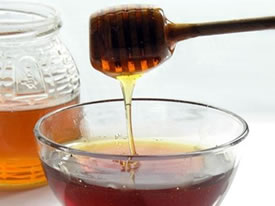A Spoonful of Sugar
As the cold and flu season hits us around the world, how and what foods can help us survive the illness? Great news, there are several remedies that each of you probably have on your aircraft, or can easily get at most hotels and from any of your aviation food sources while traveling.
The flu can be caused by more than 200 viruses, but most of the yearly seasonal flu is caused by either influenza A or B viruses. It seems amazing that the cold and flu bug we are all attempting to avoid and taking extra precautions to keep from catching still manages to grab hold of us. I decided I would research colds and flus to see what foods the science expert suggest you can eat to reduce your symptoms and make yourself or passengers more comfortable while sick. I thought I would see if there was any research to support those remedies my grandmother passed along to my mother and then on to me, and now on to my daughters.
Wake Forest School of Medicine in North Carolina, USA has proven the research that people suffering from the flu can give off small virus particles into the air at greater distances than previously thought, putting the health care workers who treat these patients at increased risk for getting the virus themselves. Stop and think about this study. If health care workers are at more risk because they are in close proximity, then what about those of you flying in a confined aircraft cabin with someone who is carrying the flu bug? The Journal of Infectious Diseases also said that “some patients were what they called "super emitters," and gave off up to 32 times more virus than the other patients.” These people, they concluded, may be more likely to pass the flu on to others.

Knowing this, you may want to be able to recognize the differences between a cold and the flu. A cold is a milder respiratory illness than the flu. While cold symptoms can make you feel bad for a few days, flu symptoms can make you feel ill for a few days and possibly even weeks. The flu can result in serious health problems like pneumonia and other illness that lead to hospitalizations. Cold symptoms usually begin with a sore throat, which usually goes away after a day or two. This is a great time to take advantage of the food remedies. Nasal symptoms, runny nose, and congestion follow, along with a cough by the fourth and fifth days. Fever is uncommon in adults, but a slight fever is possible. With cold symptoms, the nose teems with watery nasal secretions for the first few days. Later, these become thicker and darker. Dark mucus is natural and does not usually mean you have developed a bacterial infection, such as a sinus infection.
Cold symptoms usually last for about a week. During the first three days that you have cold symptoms, you are contagious. This is also the time when we all feel like we are coming down with the “bug” and continue to work. If cold symptoms do not seem to be improving after a week, you might have a bacterial infection, which means you may need antibiotics that only a doctor can prescribe.
Flu symptoms are usually more severe than cold symptoms and occur faster. Symptoms of flu include sore throat, fever, headache, muscle aches and soreness, congestion, and cough. If you have Swine flu you may seem symptoms like vomiting and diarrhea.
Most flu symptoms gradually improve over two to five days, but it's not uncommon to feel run down for a week or more. Again here is the perfect opportunity to eat high energy foods, those containing vitamin C and zinc. A common complication of the flu is pneumonia, particularly in the young, elderly, or people with lung or heart problems. A sign of pneumonia is fever that comes back after having been gone for a day or two.
If you have followed my articles, I have stressed hand washing over and over . . . hand washing to prevent cross contamination of foods and allergens. Hand washing also will help prevent cold viruses from entering your body. Flu viruses enter your body through the mucous membranes of the nose, eyes, or mouth. Every time you touch your hand to one of these areas, you could be infecting yourself with a virus, which makes it very important to keep hands germ-free with frequent washing to prevent both flu and cold symptoms. Recently when collecting data for the Catering SMS, I took bacteria swabs inside the cabin of numerous aircraft. My findings were surprising with heavy concentrations of serious bacteria on the handrails as you enter the aircraft, on seatbelt buckles and window shades, as well as the galley, lav and storage closets. Cross contamination is not only an issue for food, but also for the cold and flu bug.
With this being said, what can you do when traveling and you see these symptoms on yourself, a fellow crew member or passenger?
Let me offer a few suggestions of easily accessible cold and flu remedies can usually ease symptoms. So a spoonful of sugar . . . Honey, although, not recommended for infants (it could lead to infant botulism, a rare but potentially fatal illness), is a great soothing cough remedy.
My mother and grandmother gave me a teaspoon of honey every night before bed. What was it that they knew? If I was showing signs of a cold or the flu, then a smidge of scotch was added to the honey so that I could sleep. Studies now show that honey may reduce cough by coating and soothing an irritated throat. The age old hot toddy is made with herbal tea, a spoon of honey, a shot of whisky, scotch or bourbon, and a squeeze of lemon.
Drinking hot tea offers some of the same benefits as eating soup. The steam you inhale relieves congestion, and swallowing the hot tea comforts a sore throat and keeps you hydrated. Black and green teas have the added bonus of being loaded with large amounts of antioxidants. Green tea leaves contain antioxidants that can help to boost immune function. A recent study published in the Journal of the American College of Nutrition showed that those drinking a regular habit 23% less bouts of colds and flu overall and 36% fewer sick days. Their immune systems also produced more cells that fought off illness-causing bacteria and viruses.

We have all heard about having a bowl of chicken soup when feeling the symptoms of the cold and flu. It doesn’t matter if it is made from scratch or comes from a can. I will say that the can version will have much more salt, although good when ill because it will make you thirstier . . . the sodium helps regulate the amount of fluid in the body. Basically, the saltiness, crisps, crackers served with soup may help encourage hydration.
When you have a cold or the flu, a major symptom includes congestion in the nose, chest, and throat. Chicken soup has been shown in studies to thin mucus secretions. Broth and noodles provide carbohydrates for maintaining your energy levels, potentially helping you feel less lethargic. If you add vegetables, you’ll boost the level of nutrients in the soup, which will help support immune symptom. Components found in chicken soup have been shown to act as an anti-inflammatory by inhibiting the movement of neutrophils - immune system cells that participate in the body's inflammatory response. Additionally, it temporarily speeds up the movement of mucus, possibly helping relieve congestion and limiting the amount of time viruses are in contact with the nose lining. Now place yourself in the aircraft and consider the effects of the low humidity on your mucus membranes. Dry conditions. . Dry air also dries the mucous membranes, causing a stuffy nose and scratchy throat. Inhaling the steam off any type of hot soup or beverage can relieve nasal congestion. Sipping can help avoid dehydration and sipping can sooth inflammation, although unproven some believe it has anti-inflammatory properties.
Add some heavy hot spice and your nasal passages will also open up for relief of congestion. If your nose starts to run whenever it catches a whiff of spicy food, add some chili peppers to your dishes when you’re stuffed up. Capsaicin, the natural compound found in hot peppers that provides the heat and spiciness of the food, can thin mucus, giving you a runny nose to help you breathe better and allow your nasal passages to get rid of germs.
Maintaining good iron levels is necessary for maintaining a healthy immune system, and eating lean red meat and poultry, as well as fish and shellfish, provides a type of iron that is easily absorbed by the body. Zinc is another important mineral that these food sources provide - it serves many functions, one of which includes activating a white blood cell that helps fight off infections. While zinc does not appear to prevent colds, some research says that it may help shorten symptoms and their severity. A good suggestion is to request your catering source to suggest foods high in zinc and Vitamin C. Vitamin C is not only found in oranges, but found in high amounts in Strawberries, Sweet Red Peppers, and Broccoli.
Some studies in adults have shown that taking high doses of vitamin C daily may significantly reduce cold and flu symptoms. Other studies have seen a modest benefit in reducing the duration of a cold or flu symptoms, and a few studies have shown that taking vitamin C might help prevent colds or flu.
As the winter months move forward, and this cold and flu season moves in, take care and comfort with the old fashion food remedies that are readily available to flight crews around the globe.
 |
About Paula Kraft . . .
Paula Kraft is the founding partner of the DaVinci Inflight Training Institute located in Fort Lauderdale, Florida and the founder/president of Tastefully Yours Catering, an aviation specific caterer, located in Atlanta, Georgia for over 35 years.
Paula is active with many aviation and catering-related groups including the International Caterers Association, the International Inflight Food Service Association and is a board member of Women in Corporate Aviation. She is the past chair of the NBAA Flight Attendant Committee Caterer’s Working Group for 15 years perfecting unique catering training sessions for NBAA conferences and events. Currently, she serves on the NBAA Flight Attendant Advisory Committee and is a member of the Training and Safety Subcommittee. Paula was a founding member of the Steering committee for the creation of a European Flight Attendant Committee and conference and serves as a subject matter expert to the board of International Standard for Business Aircraft Handlers (IS-BAH).
After founding Tastefully Yours Catering, she has been offering culinary and food safety related training to the general aviation community. With a strong dedication to improving catering safety, risk mitigation and safe food handling, she developed and introduced the concept of “catering safety management systems”. As a certified food safety instructor, Paula offers catering SMS and culinary classes for all aviation professionals.
Paula’s first-hand experience, business acumen, research, and relationships make her an industry expert - one which allows her to share information that will help raise the professional training level for flight attendants today that will reduce the risk of food-related concerns tomorrow.
From Paula . . .
I have coordinated training programs and clinics for NBAA and EBAA conference attendees for over 10 years, created mentoring programs for caterers and flight attendants to broaden their aviation culinary skills, and to assist them in adapting to the unique challenges and constraints found in catering for general aviation. I recognize the need for training and have worked closely with flight departments, flight crews, schedulers and customer service reps at the FBOs to ensure that catering specific training provides information and skills necessary to reduce risk while assisting them in their job duties that include safe food handling, catering security, accurate transmission of food orders, and safe food production, packaging and delivery.
I fell into aviation catering quite by accident. I was the in-house caterer and bakery supplier for Macy’s department stores in Atlanta when catering was ordered for a Macy’s customer which was soon to change my life. After the client enjoyed the catering provided, I was summoned to the client’s corporate office to provide several of the items delivered through Macy’s to the executive dining room. Within a week, I was providing food for the flight department and my first order was for the President of a foreign country (as I was too be told soon after).
So, here I am, some 35 years later, still loving every minute of every day in aviation catering.
| © BlueSky Business Aviation News Ltd 2008-2019 |


